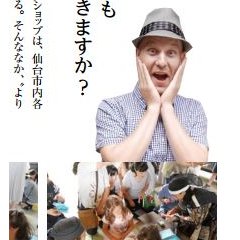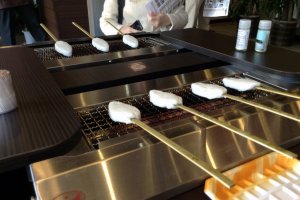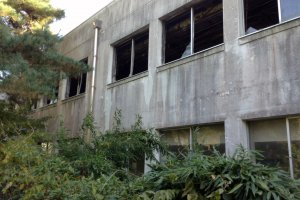Living in Sendai, I am only two hours or so by public transportation to Ishinomaki City (less if I drive) in Miyagi prefecture. I heard some rumors that Ishinomaki had some places worth checking out, but I could not say for certain. Unfortunately, relevant or current information in English about tourist attractions is lacking. Much of the information often posts a disclaimer in the article saying this is pre-March 2011 earthquake and tsunami information. The city tells me they are working on this. Ishinomaki City, being one of the hardest hit coastal communities, has undoubtedly been through much suffering. But as I saw on my first trip around the sites via chartered bus, the city is using this opportunity to more than just rebuild, but to revitalize itself. Most (I say most because there are new creations in planning) tourist attractions have recovered to the point where they are open for business and welcoming visitors from near and far. The city has food, history, pop culture, and adventure—even if on a smaller scale than larger cities. There are a few places I want to go back and visit, but for now let me give you some ideas for your next weekend in Ishinomaki.
1). Our first stop was at Takamasa Onagawa Honten, a factory specializing in kamaboko. Kamaboko is a delicacy often eaten as a snack or accompanied with tea in Miyagi prefecture. It is processed and pureed fish cleverly molded into an attractive shape, such as a leaf. Here you can receive a factory tour to see and learn how the food is made then later grill your own to eat. The company store offers a wide range of kamaboko products and flavors. Don’t be shy with the free samples!
After stopping for some of the freshest sushi I have ever eaten at one of the many sushi restaurants the traditional fishing town is famous for, it was time for the next adventure.
2). A high speed motor boat taxi ferried us to the sacred Kinkasan island. It is one of the three holiest places in the Tohoku region. It has a cluster of Shinto shrines, gates, and statues at the end of a paved uphill road from the dock. It is said a visit to the island at least once for three consecutive years will mean you never have to worry about money for the rest of your life. The island also features great hiking, picturesque scenery, and an abundance of deer (and some monkeys!). Annual festivals are also held on the island.
3). The next item on the agenda was the highlight of the trip. The Sant Juan Bautista put Ishinomaki on the map…400 years ago. The actual ship was constructed and then set sail from the Ishinomaki area all the way to Mexico under orders from warlord Date Masamune of Sendai. What you can see at the San Juan Bautista museum is a simulation movie where it feels you are in a ship, as well as small exhibits detailing the mission of people aboard the San Juan Bautista that debarked in Mexico and continued to Spain, Rome, the Philippines, and then back home. Of course, the reason everyone comes is to board the full scale reconstruction of the Sant Juan Bautista itself. It’s a beautiful ship with loads of history. Tourists will appreciate the small number of English speaking staff, English pamphlets, and English and Japanese signs explaining what is happening in each area of the ship.
Exhausted after a long day of travel and fun we ate Japanese cuisine for our evening meal at a local upscale restaurant then spent the night at a standard hotel. Before we ate a delicious breakfast at the nearby and eloquent Ishinomaki Grand Hotel, our more adventurous tour group participants braved the brisk cold to see the local farmer’s market that gathers mornings in front of the station. Various fruits, vegetables, and other foods were being sold. Hot oyster soup was very popular, having a 30 person line before opening. I settled on homemade jam for a gift for someone back home. Then we started day two of our weekend.
4). I told you this area is full of history. In addition to modern local history stretching back a few hundred years, Jomon people also inhabited the area a few thousand years ago. An easy side trip from the city is the Okumatsushima Jomon Village Museum. The museum does a great job bringing to life the adaptations a society not based on agriculture had to do to survive through its treasure of displays. For a deeper appreciation, sign up for one of the museum’s culture classes to learn how to make tools, jewelry, or fire the old-old fashioned way.
5). Ishinomaki should be remembered for its wonderful history, people, and attractions, but like it or not, the March 2011 tsunami memory will never go away—and it shouldn’t. When visiting Ishinomaki, as with other towns hit by the tsunami, don’t be surprised to see busloads of people taking advantage of what has been called recovery tourism. People want to see what happened, or every once in a while volunteer, and our group was no different. We got in touch with a local volunteer guide and learned what exactly happened that fateful day. At first I was worried it may be disrespectful or rude to bring up in conversation with locals what happened or to tour the worst of the disaster zone. That couldn’t be further from the truth. As long as you take pictures or communicate in a respectful manner, the general consensus is the city’s people are happy that others are not forgetting what happened. It is important to talk about and share. The people and tourism agencies are just hoping that this is not the only thing you will remember when you think about Ishinomaki.
For lunch, we sampled Ishinomaki styled soba which is steamed and cooked slightly differently than regular yakisoba, then topped with an egg. I enjoy yakisoba and thought this version was on par with what I have had before, but I didn’t think it was anything you must have when visiting. I would recommend, and would have much rather have had, more fresh sushi caught by the local fishermen.
A short bus ride later we were given a bird’s eye view of the town from Hiyori-yama Park. In spring, cherry blossoms and beautiful beds of flowers come to life. There are a few food vendors/restaurants and a stall selling children’s toys. The coastline is very beautiful, yet in the back of your mind you still wonder: how could something so destructive come from that beautiful blue ocean?
5). After seeing a ship with a 400 year history, an island with more than a 1000 years of history, and a Jomon museum with information from millennia ago, we were quickly brought back up to modern times with a trip to the Mangattan Museum. This museum centers on the life works of Ishinomori Shotaro. He is known as the “King” or sometimes “Emperor” of manga for his huge contributions to the manga and anime industry in Japan. He is probably best known for creating Cyborg009 and the Kamen (Masked) Rider series.
And like that our weekend was already over. There are a few places I still hope to visit in Ishinomaki and you can bet I will share them here with Japantourist. Two more times back to Kinkasan and I am a rich man. Once that happens, let’s go out for sushi, my treat.


































The Shinkansen arrives at Sendai station, in the heart of this beautiful city. Sendai has a compact, walk-able city center with a subway and many buses--with a special bus that tours just city sights. It is very convenient for those interested in shopping, sightseeing, or eating some local cuisine.
I went on a group trip that had their own bus, which is probably too expensive to rent for just a family. Reconstruction tourism, as some call it, has been growing in tsunami-hit areas. I think I will write an article or two about it in the future. Thanks for the interest! Here is a website (Japanese only) that provides tours of the areas from Sendai http://www.sendaimiyagidc.jp/datebus/datebus.php These tours are also in only Japanese. However, if you are coming to Sendai and want a tour in English, please do not hesitate to contact http://gozain.info/eindex.html for free English guide services. You would need to pay for the guide's lunch/transportation, but the interpretation and tour service is free. They can arrange a very informative tsunami tour (or anywhere in or around Sendai) for you and a group with a bit of notice. I am also part of this organization, so I would be happy to give you a tour one day! Thanks for reading and your comments!